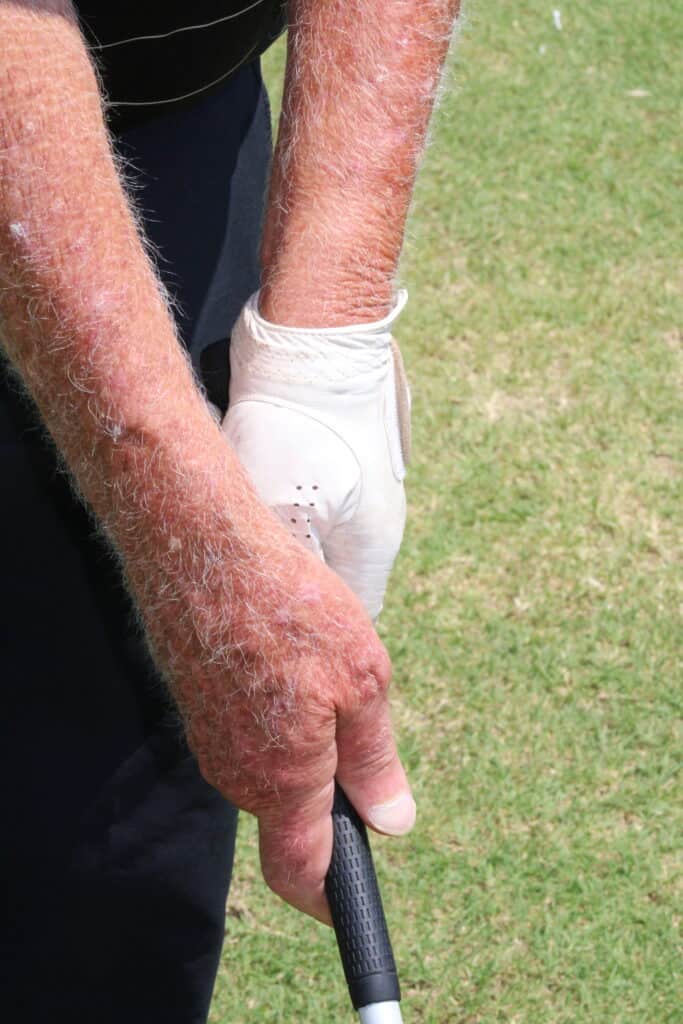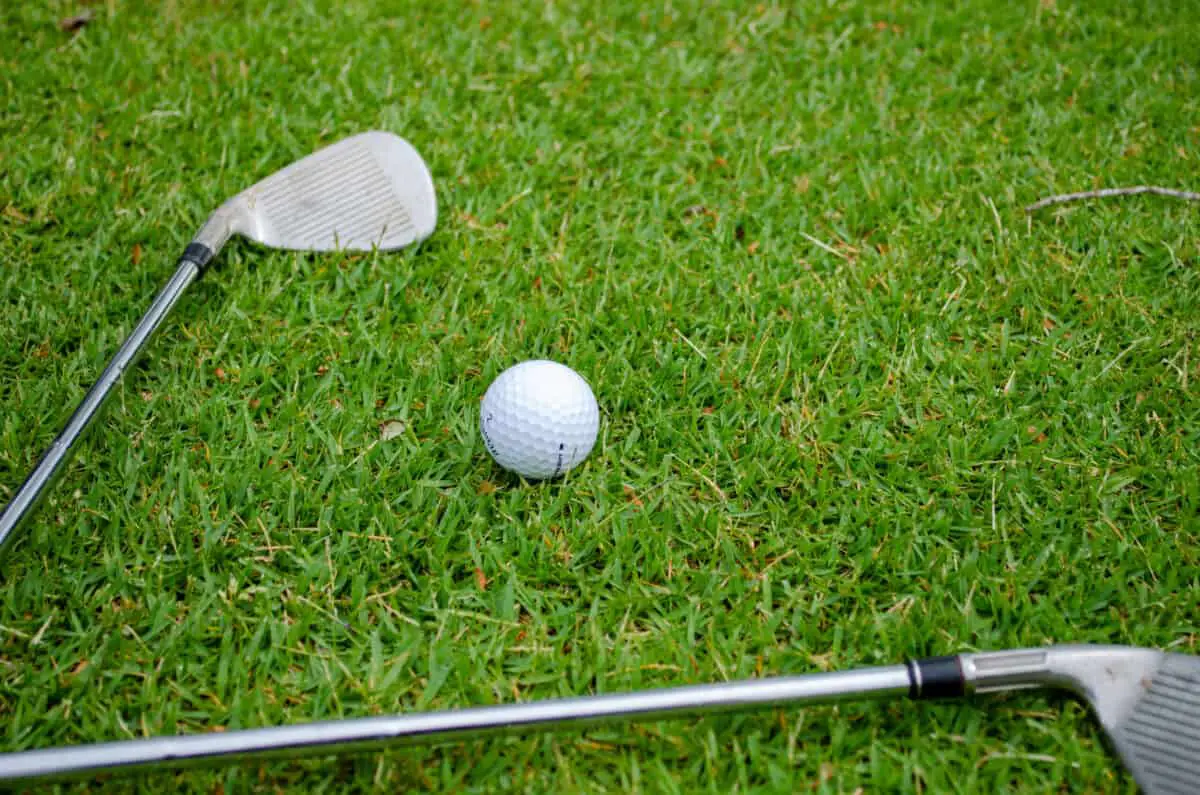In terms of club comparisons, this one features two very different clubs with various styles of striking and application on the golf course, with the 3 iron requiring a little more skill to hit successfully than the five wood.
The main differences between the 3 iron and the wood are the loft, distances, accuracy, and forgiveness, and the fact that one is an iron and one is a fairway wood makes the actual striking technique different as well, with the iron compressing the golf ball against the upsweep of the five wood.
Aside from the differences above, we will look at how the various handicap groups play these clubs in terms of average distance off the tee, on approach, and accuracy in terms of FIR and GIR – so let’s jump straight in!
Table of Contents
- Materials, Length, And Forgiveness
- Has The 3 Iron Disappeared Or Merely Morphed
- Lofts & Swing Speed
- On The Course Application
- Golf Ball Distance And Accuracy
- 0-5 Handicap Group
- 6-10 Handicap Group
- 11-15 Handicap Group
- 16-20 Handicap Group
- 20+ Handicap Group
- 3 Iron Vs. 5 Wood – Which One Do You Choose
- Fairway Wood vs Iron Conclusion
Materials, Length, And Forgiveness
The most obvious difference is that these are different types of clubs, and as such, they have some distinguishing characteristics in terms of their shaft length, clubface profiles, lofts, distances, and which players should be using in their golf bag and why.

The five fairway wood is longer and lighter than the 3 iron and may have an adjustable hosel to change the clubhead settings, which adds versatility for the player, while the 3 iron is well- the 3 iron.
The 3 iron clubface is forged or molded depending on whether it’s a muscle back or cavity back, and stainless steel is usually the material choice. The five wood clubface is also made of stainless steel or titanium, but other construction materials are added to the clubhead.
As with drivers, the head of the five wood can have carbon elements to make it lighter and various CG positions for higher launch and greater forgiveness. Although modern 3 irons may have some forgiveness if they are perimeter weighted, most don’t have the same forgiveness as the five wood.
Has The 3 Iron Disappeared Or Merely Morphed
The 3 iron is probably the second-longest iron commercially available behind the 2-iron, and and the driving iron. Over the years, the standard golf set configurations have changed. In the 70s and 80s,’ many club sets had the 2-iron as the longest club.
In the 90s, that changed to the 3 iron as more wedges and fairway woods rose in popularity, and with the advent of hybrid and game improvement irons, the 3 iron gave way, and modern sets usually have a 4i-PW as the standard set.
Interestingly, the lofts on the long irons through the years are interesting. A 3 iron typically had a loft of between 18-20 degrees, while the four iron had a loft from 21-24 degrees, depending on the brand and model.

The new four irons have lofts ranging from 18-24 degrees, with an average loft of 20.6 degrees when looking at a wide range of four irons from various brands and models. So, has the 3 iron gone, or just been replaced by the four iron with a lower loft in the set?
Lofts & Swing Speed
With a loft of between 18 and 20 degrees, the 3 iron is a flatter trajectory than the five wood with a loft of between 20 and 22 degrees, so the club loft is quite similar in range.
Hitting a 3 iron well is more complex than hitting the modern five wood, as even though the five wood is longer, the 3 iron is better suited to players with a higher swing speed.
Players who with slower swing speeds of 95mph or less on a driver will struggle to get the 3 iron airborne, and this is also because you need to hit down on the 3 iron as opposed to the upsweep required when hitting the five wood.
With your five wood, slower swinging golfers may need to look at the shaft options, while the three iron shafts would be matched to your existing iron shafts. The 3 iron would not have any option to adjust the golf club, while five woods could certainly be adjustable.
On The Course Application
It is well known that shaping the ball is easier to do with irons than with fairway woods, while fairway woods offer more consistently straight shots on off-center hits, while a long iron would punish the same strike.
Most golfers that are good ball strikers, using the 3 iron for drawing or fading will be more consistent than the five wood as it may be prone to overdrawing the golf balls. The three iron is a better option for those low-stinger shots that punch the ball out of the rough and get between 150 and 200 yards further down the fairway.
The five wood will be easier to hit out of the rough as the iron may get snagged by the longer grass on the downswing, while the upsweep club path of the five wood and the clubhead profile makes it easier to move through taller grass.

The three iron will have a lower trajectory ball flight than the five wood, so it would be better at keeping the ball more down and out of the wind, while the five wood would provide a higher ball flight, due to higher ball speed, and is not an ideal option if you have wind to contend with.
Either golf club can be hit from the tee where more accuracy off the tee is needed or where the landing area on the fairway requires a little more precision than a three wood or driver can deliver, but the five wood will generally have more distance for the tee shots.
The five will again outmuscle the three iron for average distance from the fairway but may not be as accurate on approach shots as the iron.
Golf Ball Distance And Accuracy
We know that the five wood has more distance due ball speed it generates with its length and lightness, and the three iron would have more accuracy, and now we have definitive data on this compiled from a groundbreaking collection of data from Arccos.
Not only did they capture more than 200 million shots from 3.8 million rounds through their club-mounted sensors, but they compiled this data into handicap groups. We will now look at both these clubs as they stack up in distance and accuracy based on the different handicap groups.
The handicap groups are :
· 0-5
· 6-10
· 11-15
· 16-20
· 20+
Each one looks at a distance off the tee and on approach and FIR and GIR accuracy, so let’s start with the 0-5 handicap group and see how the three iron and five wood performed there.
To see which club would be better suited to your game, simply scroll to your handicap group data.
0-5 Handicap Group
Distance
Off the tee, the 3 iron performed noticeably better, delivering 195 yards against the 187 yards of the five wood, contrary to some earlier ideas that the five wood would be further off the tee.
On approach shots, both were equal at 174 yards, so no real difference there and about 8 yards which is almost a club length difference off the tee in favor of the 3 iron.
Accuracy
Regarding the accuracy between the three iron and five wood in this handicap group, the three iron won out with 38% fairways hit vs. the 35% fairways hit by the five wood.
Both clubs were again equal for GIR accuracy, with the three iron slightly more accurate at 16.9% vs. 16,1% of the 5 wood, so the three iron is a better option if you play in this handicap group.
6-10 Handicap Group
Distance
In this handicap group, the 5 wood placed slightly ahead of the three iron in the distance off the tee with 181.7 yards vs. the 180.8 yards of the three iron. On approach shot, the five wood won out with a 5-yard advantage at 169 yards vs. 164 yards of the three iron.
Accuracy
When it came to FIR and GIR accuracy, the three iron won this round with 36% FIR against the 33% of the 5 wood and slightly better with a GIR average of 13.5% vs. the 12.9% of the 5 wood.
Considering the marginal differences in distance between the five wood and three-iron off the tee and on approach against the accuracy differences, it may be a tough choice between them at this handicap level.
Whether you consider accuracy more important than distance will determine your choice of three iron or 5 wood if you play at this level.
11-15 Handicap Group
Distance
As we progress further through the handicap groups, you will notice that the distances of both clubs tend to decrease progressively, with the 20+ handicap group having the shortest average distances and the 0-5 group having the longest.
In this handicap group, the 5 wood was 8 yards longer off the tee averaging 169 yards vs. the 161 yards of the three iron. On approach, the results were congruent with 159 yards for the five wood and 155 yards for the three iron.
This reversal happens as the ability to hit the three iron consistently well diminishes so that the distances will reduce accordingly.
Accuracy
While you would expect the 5 wood to hold the edge on the accuracy, the three iron won out in both FIR and GIR, with 32% fairways hit against the 29% of the 5 wood. It also edged the 5 wood for GIR with 11.1% against 10.3% of the 5 wood.
For this handicap group, the distances would probably be more valuable, so the 5 wood would probably be the choice of players at this level.
16-20 Handicap Group
Distance
In this second-highest handicap group, the 5 wood won out in the distance off the tee with 152 yards against the 148 of the three iron. On approach, the 5 wood came out tops against the three iron with 151 yards to 145 yards.
Accuracy
As far as accuracy goes, the 5 wood was more accurate off the tee with 28% FIR vs. the 27% of the three iron. The clubs were just about even with the 5 wood at 8.8% for the GIR stats against the three irons at 8.4%.
The balance tilts in favor of the 5 wood for this handicap group because the longer distances are the determining factor.
20+ Handicap Group
Distance
In this final group, the 5 wood continues its dominance off the tee with 136 yards against the 129 yards of the three iron, and on approach, the 5 wood has a slight distance advantage with 131 yards against 130 yards.
Accuracy
Surprisingly, the three iron was more accurate off the tee than the 5 wood with 26% accuracy against the 25.5% of the 5 wood, and half a percent is negligible. The 5 wood came out marginally ahead with 7.2% vs. 6.7% for the GIR stats.
While the other handicap groups generally favor one or the other, in this handicap group, players could realistically use either club in their golf bag and achieve very similar results, which is odd, considering that the three iron would be harder to hit consistently at this level of skill.
3 Iron Vs. 5 Wood – Which One Do You Choose
The handicap group data above would be an excellent guide to determine which club would be better, and there is no reason why you cannot have both, as your 5 wood could replace a four iron depending on the loft of your three iron.
If you tend to flush your fairway woods, then the 5 wood is the better choice but has a lower handicap player that would need more shaping capacity; the three iron would possibly take place in the golf bag.
Fairway Wood vs Iron Conclusion
When looking to choose a three iron or 5 wood, the best way is to see what feels better for you on the range or a launch monitor when trying different brands and models of each.
The best option is to take the one that gives you the most confidence when you pick it up and prepare to take a swing on the course, as this is where your choice of club matters.
- Should Tee Boxes Be Level? - January 23, 2024
- 3 Hybrid Distance - November 15, 2023
- Innovations in Golf Mobility: An In-depth Review of Top Golf Scooters - October 12, 2023
